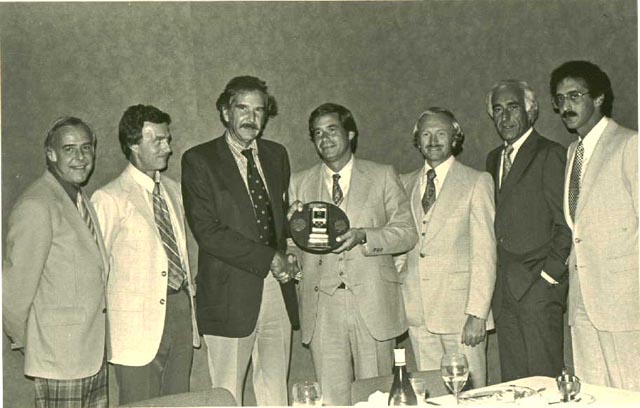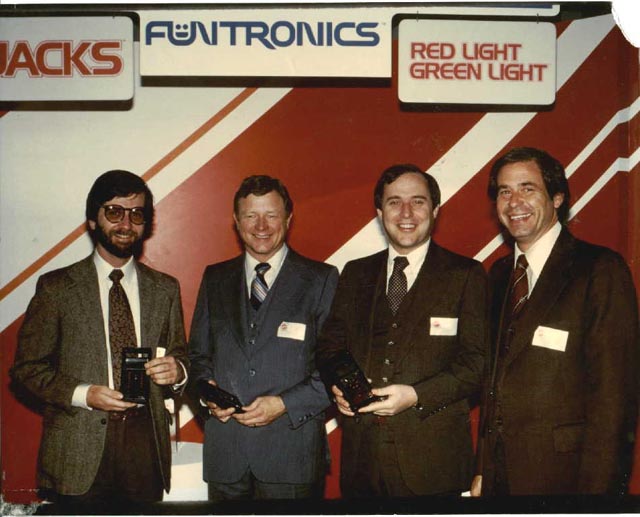 Trivia and stories
Trivia and storiesAs I have recently been in contact with the actual inventor of Mattel's Auto Race and Football (the 1st two games made), I've been able to update and correct some details of Mattel's history, as well as obtain a ton of new info about the creationg of these games. I will be adding all of this in soon, but I've made a few quick changes to a few of the sections below.
The following niformation was provided by Howard Cohen. Howard was one of the originators of the Mattel Electronics division from it's start in 1976 (although it wasn't technically a 'division' until 1981) and was Purchasing Director from then until 1981, which gave him almost total control of the production end becuase it was the first project of this size done exclusively through vendors (only the original design and packaging art was done in-house). He basically has something to do with almost every game listed here on the website, and he was the original owner of the gold plated award models. Mark Lesser (programmer of Auto Race, Football and others) also provided several details of the design process, as well as a few corrections to the information below. More to come...
What was the first game actually released to the public?
What happened to Missile Attack?
Why are there only 9 yards on the first Football game?
Why was Football cancelled after 100,000 units?
What kind of hardware is used in the games?
Was Funtronics Drag Race ever released?
About battery life.
About theft of games in stores.
Pictures of Howard (and others) at Toy Fair and an awards ceremony.
What was the first game actually released to the public?:
The first game to be made available to the public (in 1976) was Auto Race followed
by Football. Others were in the works (such as Missile Attack, which was previously
thought to be the first).
What happened to Missile Attack?: The missile attack game originally showed an outline of New York City with incoming ICBM's to be defended against (a la today's Patriot missile system concept). NBC refused to air the commercials because of the impact it would have on children to think that New York's 8 million inhabitants would be dead if they lost the game. [In response to my comment about that being a little over-cautious:] NBC was correct in their stance, in context with the times, and we should have known better. Unfortunately, it was the cold war age and anti-ICBM's were all the potential rage. Plus, we all thought we were pretty hot (what with the new technology and new thinking).
Why are there only 9 yards on the first Football?: The 9 yard football was created for technical reasons (not design problems as previously thought). I will be adding the details of this soon.
Why was Football canceled after 100,000 units?: Production was halted at 100,000 (out of an originally scheduled 500,000 material buy authorization) because the Sears, Roebuck model projections, based on initial sales figures, indicated that the game was not popular. Then, in mid-January, Sears let us know that they made a mistake and that they wanted 200,000 a week. On top of that, other sales began to take off and the quota went to 500,000 a week by mid-February (usually a time when the previous years production is over and new toys are just going through prototyping production).
What kind of hardware is used in the games?: The early models were all programmed at Rockwell Microelectronics Division using modified MOS-FET (Field Effect Transistor) handheld calculator chips. Basically a calculator chip was modified to make it output the necessary signals to drive the game display appropriately. Part of the reason that the little blips on these games are dashes is becuase they are basically the little segments of the number 8 on a calculator display (still no explaination of the Football I found with round blips though, this is a foreign manufactured version I believe).
Later games used programmable CMOS chips made (originally) by National Semiconductor. The program was imbedded in the chip at the time of production (the technology to program them "off-line" was not yet invented) and was written, to Mattel game specifications, by the NS programming staff under contract to me (Mattel). Rockwell Int'l was the major subcontractor used to manufacture the games (through their Korean and Hong Kong based assembly groups). They were also the initial source for the die-on-board technology (used militarily until we turned it to commercial applications).
Was Funtronics Drag Race ever released?: Possibly... an initial order for materials for 10,000 units was made, but might have been cancelled before the game was actually produced. By this time (it was the fourth in the series), we already knew the entire line extension was a bomb. [At least one prototype exists, which was sold on Ebay a few years back, anyone have it?] UPDATE: This does exist, I finally have one. It has Hot Wheels written on it as well, so it may have been a promo item if you bought a bunch of Hot Wheels... Not sure on this one, but I know they exist (it's just damn rare...).
About battery life: Another interesting story was that the original testing of the game revealed that the battery life was 15 hours of continuous play. This was a very short time, in an era when battery cost was a major deterrent to purchases, and had us all very concerned about the toys reception. We added a label that stated "change the battery if game malfunctions" which had never been done before (out of consumer backlash fears). We spent thousands of hours and dollars trying to improve this number and discovered that the battery life varied greatly depending upon the mode of playing. Nevertheless, besides breaking price points of the era, this was just another major change in the way toy companies could design and sell toys. Entering the "electronics" era of toys was nerve-wracking, to say the least!
About theft of games: Mattel never used masking tape to seal the boxes. In the beginning, there was no tape at all. Later on, retailers complained because the games were being stolen from their boxes (shoplifted). We reluctantly added one piece to the top and one piece to the bottom of the cheaper scotch tape at the source (a stolen game is still a sold game). [There's a way to tell if a game is one of the really early models: the box won't have any tape or tape residue on it...]

This is a picture of the awards ceremony where Howard received the gold plated 1,000,000th Basketball game.
Pictured from left to right (and their positions with Mattel at the time) are: Ray Wagner (President of Mattel Toys),
Josh Denham (Senior VP of Operations), Charlie Sporck (founder and CEO of National Semiconductor),
Howard Cohen (Project Manager of Mattel Electronics), Denis Bosley (VP - Preliminary Design Group at Mattel),
Ed Krakuar (senior Mattel Marketing exec), Jeff Rochlis (Marketing Director).

This is a picture from Toy Fair 1979 or 80. The first three people are employees
of National Semiconductor each holding a prototype of one of the Funtronics
games (looks like Red Light/Green Light, can't make out the 2nd, and then Jacks),
and the forth is Howard Cohen again. :)